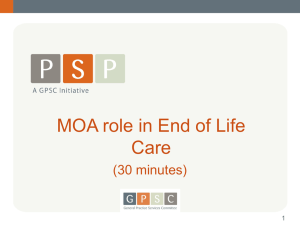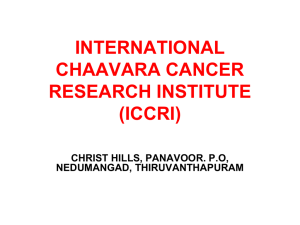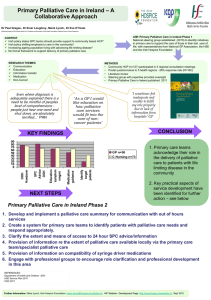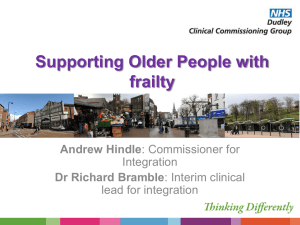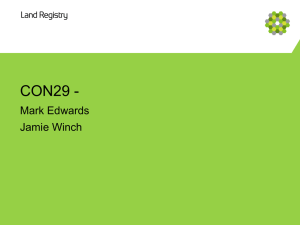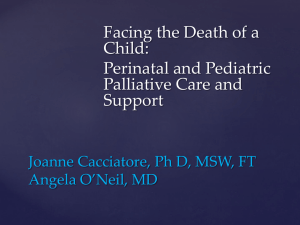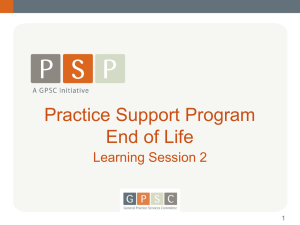Quality Metrics for Housecalls Medicine: the Current State / Linking
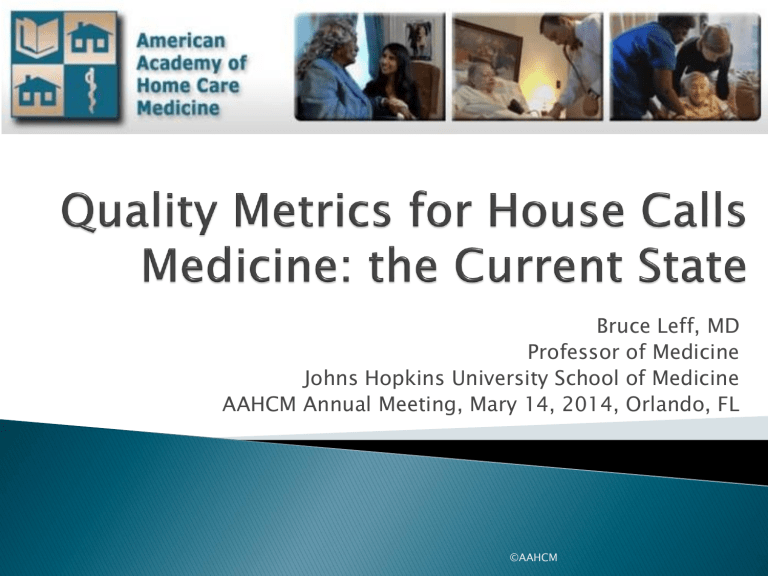
Bruce Leff, MD
Professor of Medicine
Johns Hopkins University School of Medicine
AAHCM Annual Meeting, Mary 14, 2014, Orlando, FL
©AAHCM
Frame the importance of quality measurement for house calls practices
Current state of house calls practices – readiness
Current state of what practices are doing in the area of quality measurement
Lead in to Dr. Ritchie’s talk on the future of quality measurement for house calls
©AAHCM
We don’t get enough respect for what we do
Shift to value-based care – we MUST be able to demonstrate this clearly and unequivocally to stakeholders
Challenge: lack of appropriate quality indicators, benchmarking data, mechanism to report quality
©AAHCM
Funded by The Commonwealth Fund and The
Retirement Research Fund
Created a Network of exemplar practices, patient advocacy groups, professional societies to develop quality indicators for the field, practicebased registry, tools for practice-based quality improvement
Survey of house calls practices was performed to inform our approach
©AAHCM
58-question survey
Sent to all AAHCM members – email / mail
48% response rate, 456 individuals responded = 296 practices
©AAHCM
Practice Basics
Group (v solo)
Single site v multiple, median # sites, (range)
For-profit (v not)
Sponsor
Independent provider / provider group………..
Hospital or health system…………………………
Practice funding source
Insurance reimbursement…………………………
Self-pay……………………………………………….
Subsidy by hospital or health system…………..
Philanthropy………………………………………….
Academic affiliation
©AAHCM
70
19
94
30
14
7
22
% of
Practices
56
85, 1,
(1-34)
75
Practice
Personnel
MD% w Provider,
NP
PA
RN
Med Assistant
SW
Case manager/care coor
OT/PT
Administrative
% w
Provider
Type
85
73
33
37
42
25
23
15
61
Mean
FTEs
0.5
13
5.6
4.7
1.7
2.2
6.8
1
2.2
Median
FTE
0
©AAHCM 2
1
1
1
2
2
0
0.2
Range
FTE
0-20
0-1020
0-165
0-85
0-20
0-60
0-225
0-10
0-30
Service Issues
% of
Practices
Average daily census, mean, median, (range)
Practice offers 24/7 coverage
Same day or next day visit for urgent / emerg complaints
Frequency of scheduled follow-up for clinically stable patients – every month or more frequent
Practice always or usually assumes 1º care
68
45
81
358,100,
(1-8000)
94
Practice holds regular team meetings to discuss specific patients (frequency weekly or daily)
53 (46)
©AAHCM
Practice Tech Issues
Practice uses EMR
% of Practices
88
Uses EMR for
Documentation…………………………..
E-prescribing…………………………….
Care coordination w other practices…
Registry functions……………………….
Coordinate with HHA……………………
Sign HH orders……………………………
Communicate pt preferences across settings, e.g. POLST, MOLST…………..
30
97
88
60
48
45
41
©AAHCM
Patients Served and Quality of Care
Issues
Patients served ages 65+
% Patients served in home/apt v ALF/dom
% Patients primary insurance Medicare
%
87
61
80
% Practices caring for Medicare Ad or SNP pts 63
©AAHCM
Quality of Care-Related Issues
Practice involved in NCQA PCMH
Practice is IAH site
Practice involved in ACO 13
Practice surveys patient re care experience
Annually or more frequently………………………..
Less often than annually…………………………….
Doesn’t survey…………………………………………
37
12
51
Practice uses defined quality improvement process 33
Practice collects and monitors quality indicators
% of
Practice s
14
9
48
Practice would participate in QI process that would provide feedback on house call QIs
©AAHCM
56
Factor
Practice holds regularly scheduled team meetings to discuss specific patients
Odds
Ratio
95% CI
2.25
1.13,
4.47
Practice conducts survey of patients
Practice involved in NCQA PCMH
7.57
3.76,
15.2
2.90
1.12,
7.57
©AAHCM
Range of practice types – size, biz model, provider types, approaches to quality of care issues
1/3 house calls practices use a defined QI process
Substantial proportion of practices engage in activities that may feed into QI activities: team meetings, pt and CG surveys, use of EMR
Majority of practices would be amenable to participate in QI process
©AAHCM
Christine Ritchie, MD, MSPH
Professor of Medicine
University of California San Francisco
AAHCM Annual Meeting, Mary 14, 2014, Orlando, FL
©AAHCM
Quality measurement
Trends in “value-based care”
Registries as a reporting mechanism for value-based care.
The past and ongoing work of the Medical
House Calls Network (also known as Homecentered Primary and Palliative Care)
©AAHCM
NEEDS PROCESSES OUTCOMES
Functional Functional
Clinical
Costs
Expectation Clinical
Assess>>Dx>>Rx>>Follow
Costs
Satisfaction
Patients with need Patients with need met
©AAHCM
Expectations for measurement and QI activities in five “quality domains”
◦ Clinical care
◦ Safety
◦ Care coordination
◦ Patient & caregiver experience
◦ Population health
◦ Prevention
Reimbursement (positive and negative) predicated on performance on certain quality measures and clinical performance improvement activities
©AAHCM
Most quality measures are:
◦ disease focused
◦ Not applicable to those with functional limitations
◦ Not applicable to those who are home-limited
Housecalls (Home-centered Primary and
Palliative Care) is at risk:
◦ Of not all being Patient-centered Medical Homes
◦ Not have professional society/discipline/settingspecific measures/standards
©AAHCM
Measures that…
◦ Make sense for home-centered primary/palliative care (HCPPC) practices
◦ Take into account multiple chronic conditions
◦ Are validated in homebound populations
A Registry for…
◦ HCPPC practices
◦ Meeting quality reporting requirements
◦ Benchmarking
A Network to…
◦ Develop and test measures
◦ Test and implement a registry
©AAHCM
•
House Call Doctors
•
Kaiser Family Foundation
•
Amer. Acad. of
Hospice/Palliative Med.
•
Senior Advocate
Resources
•
Amer. Acad. of Home
Care Med
•
National Partner. Women
& Families
•
Mount Sinai Visiting
Doctors Program
•
Cleveland Clinic Med.
Care at Home
•
Call Doctor Medical Group
•
Visiting Physicians Assoc.
•
Vir. Commonwealth Univ.
•
HomeCare Physicians
•
Washington Hosp. Ctr
•
Department of Veterans
Affairs
•
AARP Public Policy Institute
•
American Geriatrics Society
•
Johns Hopkins Elder House
Calls
•
Housecall Providers
•
Measure development
• Comprehensive literature review
• Health/Human Services Multiple Chronic Conditions Framework
• Qualitative interviews with all network members
• Qualitative interviews with patients and caregivers
• Development of standards from 10 domains
• Iterative refinement of standards
•
Mapping of measures:
• Over 2000 measures
• Culling process over 16 calls and 4 months
• Final number: 95 measures
• Second culling process: 48 measures
• RAND modified Delphi process: 30 measures
Domains and Standards
Domain: Assessment
Perform a comprehensive assessment that includes:
• Symptoms (physical, emotional, social, spiritual)
• Physical, executive and cognitive function
• Health literacy
• Patient goals and sources of meaning and purpose
• Care coordination needs
• Treatment burden experienced by patients and caregivers
• Patient and caregivers stressors
• Social support and social risk
• Safety concerns
Gaps
Domains and Standards
Domain: Care Coordination
• Coordinate handoffs between care settings
• Communicate patient treatment goals and preferences across settings
• Identify and use appropriate community resources
• Insure that all team members have access to key patient information
• Assure that the team is notified of sentinel events
Domain: Quality of Life
• Optimize comfort and safety of home environment
• Manage symptoms
• Reduce treatment burden
• Employ preventive services to optimize function
Gaps
Organized system--use observational study methods to collect uniform data
Provide population-level reports
– Real-time/rapid cycle
– Risk adjusted
– Including standardized measures
– Including benchmarks
– Different reports for different levels of users
Generate dashboards that facilitate action
Facilitate third-party quality reporting
©AAHCM
©AAHCM
©AAHCM
Work with the Academy and other professional societies to have standards approved for care in this setting
Begin registry development process (in partnership with the Duke Center for Learning Healthcare
Support housecalls practices in their recognition as a credible setting of care (Home-centered
Primary/Palliative Care)


